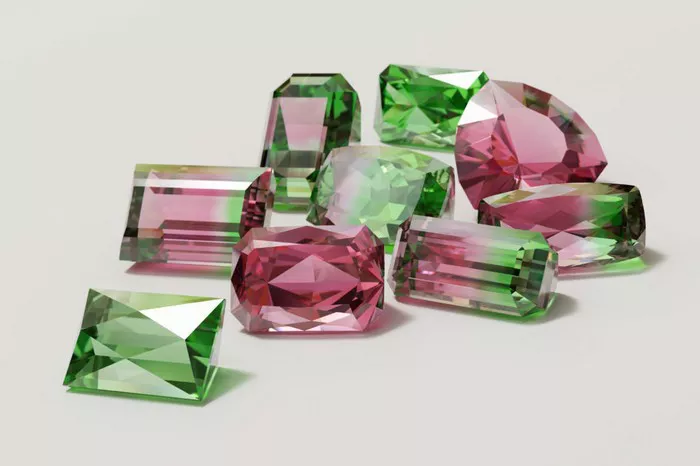Tourmaline, also known as the “rainbow that fell to earth,” holds a unique position among gemstones. Its vibrant colors and rich history make it a standout choice as the official birthstone for October. This article will delve into the reasons why tourmaline is designated as the October birthstone, exploring its origins, characteristics, colors, and significance.
Origins and Name
Tourmaline’s name is derived from the Sinhalese (Sri Lankan) word “Turmali,” which translates to “mixed-colored stone.” This name aptly describes the gemstone’s most notable characteristic: its ability to display a wide range of colors within a single crystal. The term “tourmaline” entered the English language through various translations and eventually became the standard name for this type of gemstone.
Composition and Properties
Tourmaline belongs to the tourmaline family of minerals, which are characterized by their ring silicate structure containing boron, aluminum, sodium, iron, magnesium, and lithium. This complex chemical composition leads to tourmaline’s diverse color palette, ranging from deep reds and greens to blues, blacks, and even colorless varieties.
The hardness of tourmaline on the Mohs scale ranges from 7 to 7.5, making it suitable for everyday wear. This durability, combined with its ability to resist most chemicals and light exposure, ensures that tourmaline jewelry retains its beauty over time. However, it’s important to note that high temperatures can damage tourmaline, so it should be cleaned using warm water, mild soap, and a soft brush, rather than ultrasonic or steam cleaners.
Color Palette
Tourmaline’s color range is one of its most fascinating attributes. It can be found in almost every color imaginable, including red, blue, yellow, green, black, white, and bicolor combinations. Here are some of the most popular and rare types of tourmaline:
Red Tourmaline
Rubellite: A rare and valuable type of red tourmaline with a pinkish hue that distinguishes it from rubies.
Bixbite: A form of red tourmaline with a particularly strong and vivid color.
Green Tourmaline
Chrome Tourmaline: Exhibits a highly saturated green color that is similar to emeralds but more vivid.
Paraíba Tourmaline: Known for its neon blue-green hues due to the presence of copper. This variety is particularly rare and valuable.
Blue Tourmaline: In addition to Paraíba, there are other blue shades of tourmaline that range from light to dark blue.
Black Tourmaline: Rich in iron, black tourmaline is not translucent like other colored varieties.
Watermelon Tourmaline: A unique type of green tourmaline with a pink center surrounded by white and green hues, resembling a watermelon.
Colorless Tourmaline: Also known as white tourmaline, it is less valuable on the market but can be quite striking if it exhibits special optical effects like cat’s eye.
Historical Significance
Tourmaline has been revered throughout history for its captivating colors and mystical properties. Ancient civilizations believed that tourmaline could protect against evil spirits and bring good fortune. In fact, some legends suggest that tourmaline traveled to the center of the earth and passed through a rainbow, acquiring all the colors of the rainbow in the process. This is why tourmaline is sometimes referred to as the “rainbow gemstone.”
In the West, tourmaline gained popularity during the Victorian era when it was used in a variety of jewelry pieces. Its vibrant colors and relative durability made it a favorite among jewelers and collectors.
Symbolism and Beliefs
As the October birthstone, tourmaline is believed to bring inspiration, action, and vitality to those who wear it. It is also associated with hope, peace, and protection. Each color of tourmaline is thought to correspond to different emotions and energies, making it a versatile gemstone for those seeking to balance their lives.
Mining and Production
Tourmaline is found in various locations around the world, including Brazil, Madagascar, Sri Lanka, and the United States. Some of the most famous tourmaline mines are located in Maine, where the Dotton Mine near Graphite Mountain is known for its productive yields. In California, the first commercial tourmaline mine opened in 1898 in the Mesa Grande area of the Himalayan pegmatite district.
A notable historical event involving tourmaline is its mining in Santiago, California, to fulfill the demand of Empress Dowager Cixi of China, who was fascinated by the gemstone’s bright colors. Between 1902 and 1910, over 120 tons of red tourmaline were shipped to China. However, the mining boom ended shortly after Cixi’s death in 1908 and the fall of the Qing Dynasty. Today, only a few mines in San Diego County occasionally produce gem-quality tourmaline.
Care and Maintenance
To keep tourmaline jewelry looking its best, it’s important to clean it regularly using warm water, mild soap, and a soft cloth. Avoid using harsh chemicals or abrasive materials that could scratch the gemstone. Additionally, store tourmaline jewelry separately from other pieces to prevent scratches and maintain its shine.
Popular Tourmaline Jewelry
Tourmaline’s vibrant colors and durability make it a popular choice for a variety of jewelry pieces, including rings, necklaces, earrings, and bracelets. Here are some examples of popular tourmaline jewelry:
Pink Tourmaline and Diamond Ring: A stunning piece that combines the soft hues of pink tourmaline with the brilliance of diamonds, set in platinum or white gold.
Paraíba Tourmaline Pendant: A rare and valuable piece featuring the neon blue-green hues of Paraíba tourmaline, often set in gold or platinum with diamond accents.
Tourmaline and Sapphire Bracelet: A colorful bracelet that alternates tourmaline gemstones with sapphires, creating a striking and elegant design.
Conclusion
In summary, tourmaline’s designation as the October birthstone is well-deserved, given its unique combination of beauty, durability, and historical significance. Its vibrant colors, which range from deep reds and greens to blues, blacks, and whites, make it a versatile gemstone that can be enjoyed by people of all tastes and preferences. Whether worn as a symbol of hope and protection or simply for its aesthetic appeal, tourmaline jewelry is a cherished addition to any collection.
Related topic:
- Is Black Tourmaline Easily Broken?
- Obsidian or Black Tourmaline: Which Is More Suitable for Jewelry?
- What Are the Different Characteristics of Obsidian and Black Tourmaline?


